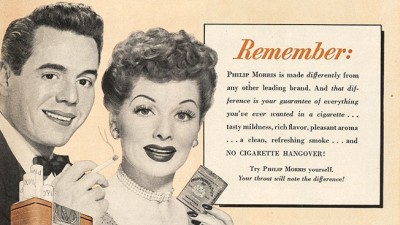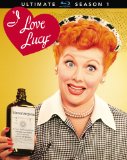| Reviews & Columns |
|
Reviews DVD TV on DVD Blu-ray 4K UHD International DVDs In Theaters Reviews by Studio Video Games Features Collector Series DVDs Easter Egg Database Interviews DVD Talk Radio Feature Articles Columns Anime Talk DVD Savant Horror DVDs The M.O.D. Squad Art House HD Talk Silent DVD
|
DVD Talk Forum |
|
|
| Resources |
|
DVD Price Search Customer Service #'s RCE Info Links |
|
Columns
|
|
|
I Love Lucy: Ultimate Season 1
I Love Lucy (1951-60) forever changed the television landscape in myriad ways, many having little to do with the show itself. It reconfigured the legacies of its stars, for one. Heretofore, Desi Arnaz had been a Cuban bandleader, a not-insignificant force in the ‘40s Mambo movement. But beginning with I Love Lucy Arnaz became one of television's most important and innovative producers. Among other things he helped create the "three-camera, live-on-film" style of sitcom production still in use 65 years later. He leveraged I Love Lucy's runaway success to set precedent-making deals in the marketing of reruns (I Love Lucy is without doubt the oldest network show still widely rerun), and with then-wife Lucille Ball created the television empire that was Desilu. Consider this: Without Desilu (and Ball's somewhat bemused support) there probably would never have been Star Trek or Mission: Impossible franchises.
Were it not for I Love Lucy, the former second-tier Hollywood star would be no more a household name than, say, Priscilla Lane or Virginia Grey (the latter a longtime friend of Ball's). Within Desilu she built her own Kingdom of Lucy, a constant TV presence that lasted until 1974 when her third sitcom, Here's Lucy, finally ended. All these years later she's still regarded as the First Lady of Television.
As for I Love Lucy, regardless of its aesthetic value, it's never gone away. Even during and immediately after its first run it continued being broadcast over CBS for a time, then became a fixture in syndication, in some markets running as many as 12 times per week, 52 weeks per year. Forget the famous episodes: Vitameatavegamin, Lucy stomping grapes, Lucy and Ethel packaging chocolates on that conveyor belt. A good percentage of American viewers, at least of my generation and earlier, have probably seen every episode of I Love Lucy multiple times. ("Oh, it's that one," we think to ourselves five minutes in.) Up until about 30 years ago, I Love Lucy was practically unavoidable.
Especially when viewed in their original network broadcast versions (an essential option), I Love Lucy today comes off as a real relic, very much a product of the early 1950s. This is not to take away from the show's many achievements, but rather to note I Love Lucy: Ultimate Season 1's many surprises. Except for a Criterion laserdisc of 20 odd years ago, I hadn't seen the show since the 1970s. Oddly, it didn't seem dated at all back then but now certain aspects of the show seem positively prehistoric. More about this below.
I Love Lucy's reputation as the funniest comedy of the ‘50s also has dimmed a bit in the DVD era, with audiences rediscovering the pleasures of equally funny or superior shows like Sgt. Bilko, The Honeymooners (including those long-"lost" episodes), episodes of The Colgate Comedy Hour, and You Bet Your Life, among others. But I Love Lucy still plays well. If its situations aren't fresh now they sure seemed so then and for many years to follow, and the performances of Ball, Arnaz, and the invaluable support of William Frawley and Vivian Vance are as funny as they ever were.
Paramount/CBS's Ultimate Season 1 is just that. Because the show had the foresight to shoot on 35mm film stock (rather than broadcast live with kinescope rebroadcasts, the norm for early-‘50s comedies), this has allowed for excellent high-def remasters that look great even on big screens. And, as with Ball's other two long-running series complete in DVD format (The Lucy Show and Here's Lucy), this is packed to the gills with worthwhile and very enlightening extra features. It's one of the best Blu-ray releases of 2014
I Love Lucy…and Phillip Morris
I Love Lucy's origins, like many a ‘50s sitcom, were in radio. Ball was starring in a weekly series called "My Favorite Husband" that seemed destined for television, but Ball would only agree if real-life husband Desi Arnaz rather than radio husband Richard Denning could appear opposite her. Ball was by this point middle-aged and wanted to reign in her husband's notorious philandering and carousing. She hoped a TV series that her husband would also produce would keep him occupied.
The series was picked up by CBS through unfortunate circumstances. The fine comedy-drama The Goldbergs was suddenly dropped when creator-star Gertrude Berg refused to fire the man playing her husband, blacklisted actor Philip Loeb. Ball herself was later accused of being a Communist sympathizer but survived the witch-hunt. That I Love Lucy enjoyed ratings so high at one point it was pulling in more than 70% of the viewing audience no doubt helped.
The series was sponsored by Phillip Morris, the cigarette manufacturer and, much less so than the more familiar syndicated versions of I Love Lucy, a haze of cigarette smoke permeates every episode. Ads before, after, and sometimes during each show hilariously/frighteningly extoll the health "benefits" of Phillip Morris smokes over every other brand. (Interestingly, the second person to appear on-camera in the very first I Love Lucy is announcer John Stephenson, who must be the last-surviving adult to appear on the series. Later known as the voice of Mr. Slate on Flintstones and innumerable other Hanna-Barbera characters, at 90 he's still with us.)
Their sponsorship also helps explains why housewife Lucy and bandleader Ricky Ricardo (Ball and Arnaz) and their neighbors/landlords, Fred and Ethel Mertz (Frawley and Vance) are constantly lighting up. In the original broadcast versions, blatant product placement was not uncommon. The radio quiz show Lucy appears in one episode has a new potential sponsor in Phillip Morris, for instance, and in the famous episode where Lucy climbs inside her disemboweled TV to perform for Ricky, her familiar "Ta-da-ta-ta-TA!" is immediately followed by the brand's famous catchphrase, "Call for Phillip Morris!" Did I mention that most of the cast died of smoking-related illnesses?
The series is firmly stuck in the ‘50s in other ways. In the first episode, "The Girls Want to Go To the Nightclub," specifically The Copacabana, while Ricky Ricardo, of course, works at The Tropicana, entertainment venues harking back to an earlier age and all but extinct in that form by the end of the decade. (Also in this same show, the girls dress up like hillbillies, a nod to then-popular comedies like the Judy Canova and Ma & Pa Kettle movies featuring them.) In another early show, very illustrative today, the Ricardos and the Mertzes attempt to spend an evening together doing anything other than watch TV, as novel a narcotic in 1951 as Facebook and iPads are today. When someone suggests they listen to the radio, they can barely recall what that experience is like.
The four stars make the show funny. This Lucy, versus the characters Ball would subsequently play on The Lucy Show and Here's Lucy, wasn't the often-grating, sometimes infantile older dingbat, but rather an ordinary if eccentric housewife forever scheming to buy a new dress or, more often, enter the world of show business despite a total lack of talent. As Bart Andrews noted in his seminal book on the making of the series, the format typically pitted the women against the men, the Ricardos against the Mertzes, or Lucy against Ricky, always with Lucy hatching some wild plan that invariably goes horribly awry. These early I Love Lucy episodes are bereft of Hollywood stars, with more "pure" sitcom situations: Lucy dividing their New York apartment in half for "Men Are Messy"; an epic battle between the Ricardos and the Mertzes in "Breaking the Lease"; Lucy bakes bread with disastrous results in "Pioneer Women," etc.
Video & Audio
I Love Lucy looks quite good on Blu-ray, especially when one takes into account that these shows were more or less shot in real time, with cinematographer Karl Freund's crew having to scramble their dollying cameras into focus and in synch with the sometimes complex blocking of the actors, to and from multiple sets. The original network material (preserved in 16mm) is in more dog-eared condition but still acceptable and the transitions are pretty seamless. The 2.0 lossless mono is also good when one remembers all the pops and crackles on 16mm syndication prints of yore. A Spanish Dolby Digital track is offered, and the discs are region-free.
Extra Features
The bountiful extras are, as the saying goes, sure to please any fan. There are costume and make-up tests in high-def that reveal every flaw in Ball's and Arnaz's faces. "Before and After" restoration demos are likewise enlightening. A 1990 network special, "I Love Lucy": The Very First Show looks at the unaired pilot, also available separately in its entirety. Also in standard-def is a 1951 promo for the series; back in HD are noteworthy Flubs, with particular mistakes during production carefully pointed out. Text biographies of guest stars and even sponsor personnel are included, while audio-only wise there's the excellent 1991 laserdisc audio commentary, originally made for Criterion, featuring archival and then-new interviews with Ball, Arnaz, producer Jess Oppenheimer, writers Bob Carroll, Jr., Madelyn Pugh, director William Asher, actors like Jerry Hausner, Doris Singelton, and Mary Jane Croft, as well as series historian Bart Andrews. Also included are several "My Favorite Husband" radio episodes and excerpts from Oppenheimer's audio book of Laughs, Luck…and Lucy. A slide show and photo gallery round out the extra features.
Parting Thoughts
A terrific package of material almost perfectly presented, I Love Lucy: Ultimate Season 1 is a DVD Talk Collector Series title.
Stuart Galbraith IV is the Kyoto-based film historian and publisher-editor of World Cinema Paradise. His credits include film history books, DVD and Blu-ray audio commentaries and special features.
|
| Popular Reviews |
| Sponsored Links |
|
|
| Sponsored Links |
|
|
| Release List | Reviews | Shop | Newsletter | Forum | DVD Giveaways | Blu-Ray | Advertise |
|
Copyright 2024 DVDTalk.com All Rights Reserved. Legal Info, Privacy Policy, Terms of Use,
Manage Preferences,
Your Privacy Choices | |||||||














